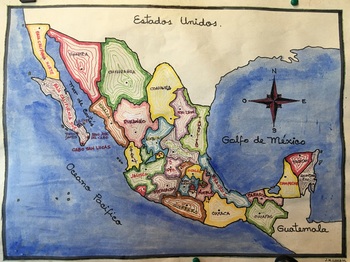
Born in Texas, poet and Chicana activist Gloria Anzaldúa (1942-2004) has described the space inhabited between English and Spanish, between American and Mexican identity, as the Borderlands. The commingling of English and Spanish in Anzaldúa's celebrated poetry underscores the hybrid identity, or third space, she and others like her inhabit. Here, I explore the stories of two bilingual people I met during my summer in Mexico.
To live in the Borderlands means knowing
that the india in you, betrayed for 500 years,
is no longer speaking to you,
that mexicanas call you rajetas,
that denying the Anglo inside you
is as bad as having denied the Indian or Black;
From Gloria Anzaldúa (1987), Borderlands-La Frontera. The New Mestiza (San Francisco: Aunt Lute Books, 1987), pp. 194-195. india: Indian, indigenous woman; rajetas: split, neither here nor there
Encountering Bilingual Identity in Rural Mexico.
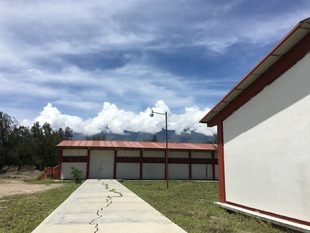 Mountaintops rise behind the school's campus.
Mountaintops rise behind the school's campus. Turning away from the mountain view, I walked into the school to being assisting freshmen and sophomores in improving their English. That first day, I was surprised to meet quite a few that had been born in the States. Now teenagers, they spoke English more comfortably than their peers, recalling early years in Los Angeles city schools, and their favorite American foods and primetime TV. Many hoped to return to the U.S. to pursue their college education, as childhoods across the border had left them feeling more American at times than Mexican.
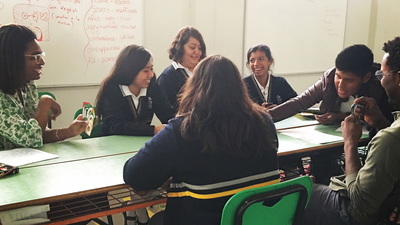 Playing Uno as we practice speaking English.
Playing Uno as we practice speaking English. After we split into pairs to compose short stories, Jackie launched into an anecdote about her bilingual identity. Lowering her voice, she told me how she remembers being chastised for using English when she first arrived in Mexico. She was 7 or 8 years old when she asked for a "soda" in the corner store. She realized her language choice was a problem when the shopkeeper demanded she say the Spanish word refresco (soda) before giving her the orange Fanta she wanted. This encounter became the point at which she truly understood she was no longer in the U.S.
Revisiting the (Invisible) Borderlands.
Cuando vives en la frontera,
people walk through you,
the wind steals your voice,
you’re a burra, buey, scapegoat,
forerunner of a new race,
half and half —both woman and man, neither— a new gender
To survive the Borderlands
you must live sin fronteras
be a crossroads.
From Gloria Anzaldúa (1987), Borderlands-La Frontera. The New Mestiza (San Francisco: Aunt Lute Books, 1987), pp. 194-195. burra: donkey; buey: ox; sin fronteras: without borders
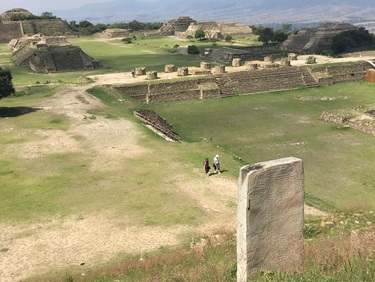 View of Monte Albán from atop the courtyard ridge.
View of Monte Albán from atop the courtyard ridge. "¿De dónde vienes?" (Where are you from?)
"De California." (From California.)
"Bueno. Pues, viví allá por años, estaba trabajando en los campos de fresas y en otras cosas. Pero eso no sirvió, y regresé acá." (Okay. Well, I lived there for years, I was working in strawberry fields and in other things. But there wasn't much money in it and I returned here.)
We talked a bit more before I made the modest climb, but what he had shared with me left as strong an impression as the incredible view. He had wanted me to know that he intimately knew my home country, and that the U.S. had been his home for many years as well. He had called Los Angeles, Stockton, and Chicago each home, before returning to Mexico.
Our encounter reminded me of how limiting it was to judge a book by its cover, or judge a man by his appearance, no matter the context. Over the years, my many extended stays in Mexico were often peppered with questions from locals, and their resulting surprise at someone of my skin color being from the U.S., rather than from Cuba, as they imagined. I wasn't quite the American they pictured when they thought of their neighbors to the north, but there I was.
Engaging Mexico's Political Saavy: #CONTRATRUMP.
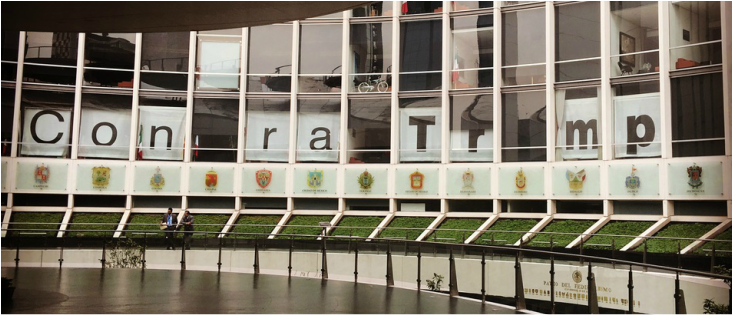 #CONTRATRUMP: Posters in protest at the Senado de la República.
#CONTRATRUMP: Posters in protest at the Senado de la República. On an overcast July day I took a taxi down to Paseo de la Reforma, the iconic high-rent broadway which the U.S. Embassy calls home, along with a number of American hotel brands. I was on my way to see a friend at the Mexican National Senate (Senado de la República). During my visit, we went out into the courtyard to take in the skyline, and looking up, I noticed a number of huge posters plastered across the windows of several government offices. It was clear they spelled the hashtag #CONTRATRUMP (AGAINSTTRUMP). When my friend explained that these posters had already been up for four months, I took it as further evidence that American domestic news headlines had not escaped the Mexican public. Far away from the center of it all, on the other side of our mostly invisible border, U.S. politics was have a greater impact than I could have anticipated.
A History of Anti-Immigrant, Anti-Mexican Political Discourse.
As one Trump supporter was quoted by The New York Times: "If you're not speaking English, and you're not contributing, get out!" In the days since the Republican and Democratic national conventions, just as many people spouting this divisive rhetoric have condemned it, citing their surprise at the emergence of this shameless hate speech.
The awful truth is that political discourse doesn't change overnight, and there have been several anti-immigrant, anti-Mexican, and anti-difference undercurrents simmering and bubbling in America since before
- Mexico's attempt to free its Texas territory of slavery after 1810, when enslavement gradually became illegal in Mexico,
- the U.S.-Mexican War (1846-1848),
- and the subsequent cession of formerly Mexican (and Spanish) territories extending from California to Wyoming.
Brown and Black skin, along with languages other than English were seen as signs of uncivilized disorder. Biological theories of inherent inferiority were used to support Manifest Destiny, and explain White supremacy as inevitable and necessary. Let us also remember that in its early days as a Spanish territory and missionary outpost, the American West was settled by Spanish-speaking explorers, religious leaders, and Afromexicans, before its significant Anglo presence. Barring this colonization, the area remains home to a wide array of indigenous cultures and languages.
In times since, the increasing visibility of people of color, some identifying as Latinx, some speaking Spanish or practicing a variety of religions, has drawn the ire of many who are cynical and fearful of difference, and want to maintain control of an America they think they know and love. At his own rally on Thursday, August 4, Trump openly lamented: "Our country is becoming different...they're shooting our police...we need law and order." As we revisit these historical truths, we must ask ourselves what type of order is it that he really portends. Will students like Jackie be welcome in Trump's America?
"Reject Cynicism and Reject Fear."
With global attention on the 2016 election, there seems to be even more pressure to discuss the severity of the choices at hand. I've been paying attention to the presidential race all along, but it wasn't until after I returned to the U.S. that I fully gathered just how misleading and polarizing our political discourse has become.
Particularly at a time when America signifies so many things to so many people, my time in Mexico reminded me that I could learn about my home country by looking from the outside in. Division and difference can never be the answer, no matter what side of the border you're on.
 RSS Feed
RSS Feed